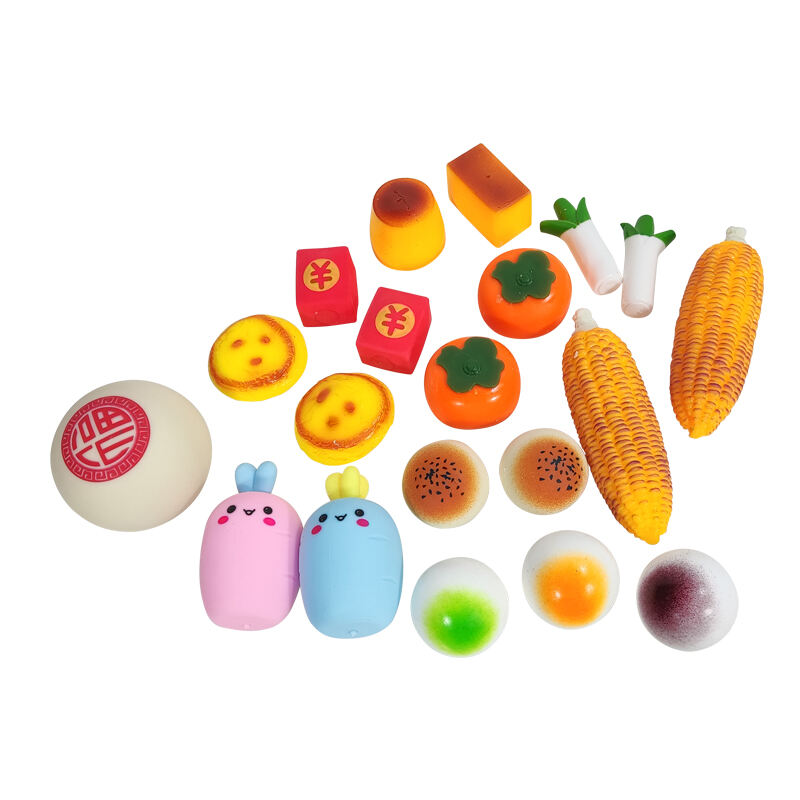Tundma õppimismängu ja selle roll laste arengus
Mis on tundma õppimismängud ja kuidas need toetavad erivajadustega lapsi?
Tundma õppimismängud stimuleerivad erinevaid meeli, nagu nägemine, kuulmine, puutetunne, liikumine ja mõnikord isegi lõhnu. Need esemed aitavad lastel töödelda kõiki nende ümbrusest pidevalt tulevaid sensoorseid signaale. Erivajadustega lapsed, sealhulgas autispektril olevad lapsed või lapsed, kellel on sensoorse töötlemise raskusi, leidavad neid mänge eriti kasulikuks, kuna need pakuvad turvalist ruumi oma ümbrusega suhtlemiseks. Näiteks tekstuuridega mängud aitavad aja jooksul tekstuuridele vastupidavust arendada. Valgusprojektorid võivad olla eriti kasulikud lastele, keda vilkuv valgus või teatud värvid üle koormavad. Kui lapsed saavad nendelt mänguasjalt pidevaid sensoorseid tagasisideid, aitab see neil paremini reguleerida oma emotsioone ja tunnetada end mängimisel turvalisemana, mis muudab kogu kogemuse nauditavamaks kõigile osapooltele.
Sensomotoorse mängu ja laste kognitiivse arengu vaheline seos
Kui lapsed mängivad sensoorsete mänguasjadega, siis nende aju loob tegelikult tugevamaid ühendusi, mis aitavad neil paremini õppida. Laste arengu instituudi 2023. aastal tehtud uuring vaatas seda nähtust üsna põhjalikult läbi. Nad märkasid midagi huvitavat: lapsed, kes veetsid igapäevaselt umbes pooled tundi korraldatud sensoorsete tegevustega, arendasid probleemide lahendamise oskusi ligikaudu 19 protsenti kiiremini kui need, kellel sensoorset stimulatsiooni oluliselt vähem oli. Mõelge näiteks erineva tekstuuriga kuubikute kokkupanemisele või erinevate kuuldavate helide sobitamisele. Just sellised praktilised kogemused suurendavad oluliselt laste mälu ja mustriülesannete tuvastamise oskusi, mis osutub hilisemaks toeks õppimisel lugema ja tegema lihtsat matemaatikat.
Sensoorsete mänguasjade tüübid: tekstuuriline, kuulmine ja visuaalne stimulatsioon
| TÜÜP | Näited | Arengulised eelised |
|---|---|---|
| Tekstuuriline | Pliksuvad stressipallid, villast tahvlid | Parandab taktilist eristusvõimet |
| Kuulmine | Vihmategijad, helisobitamise mängud | Täpsemaks teeb helide eristamise |
| Visuaalne | Kiudoptilised lambid, vedelikukellad | Parandab keskendumist ja jälgimisvõimet |
Kuidas sensoorne sisend toetab neuroloogilisi radu erivajadustega laste arengus
Korduvad sensoorsed kogemused aitavad ümber programmeerida liialt või ebapiisavalt reageerivat närvisüsteemi. Proprioceptiivsed vahendid, nagu kaaludega tekkid, ja vestibulaarsed abivahendid, nagu tasakaaluplaadid, aktiveerivad ajupiirkondi, mis vastutavad ruumitaju ja emotsionaalse reguleerimise eest, toetades igapäevaste sensoorsete väljakutsete suhtes kohanevaid reaktsioone.
Sensoormänguasjad erivajadustega lastele: toetus arengule ja reguleerimisele
Autismi ja ADHD toetamine sensoormänguasjadega: keskendumise ja eneseregulatsiooni tugevdamine
Sensoormänguasjad pakuvad sihendatud toetust keskendumisele, emotsionaalsele reguleerimisele ja sensoorsete andmete töötlemisele lastel, kellel on autism või ADHD. Neuronoloogiliste erinevuste arvestamine aitab neil vahenditel parandada tähelepanu, vähendada ärevust ja soodustada ohutumaid õppimiskeskkondi.
Sensoormänguasjade kasu lastele, kellel on autism või ADHD
Uuringud näitavad, et sensoorsete mänguasjade kasutamine suurendab koncentreerumist kuni 34% lastel, kellel on ADHD (Ponemon 2023), samuti vähendades ärevust ja emotsionaalseid kokkuvarisemisi autistlike laste puhul. Peamised eelised hõlmavad:
- Stressi vähendamine : Kaalukatted ja tekstuurirohked pinnad annavad rahustavat proprioceptiivset sisendit.
- Ülesande kaasatuse : Mängimisvahendid nagu keerutajad või hammustamiseks sobiv ehted suunavad ärgliku energia produktiivsele fokuseerimisele.
- Sensoorne integreerimine : Rütmilised helimänguasjad aitavad lastel töödelda keskkonnamärgusi, ei ülekoormata.
2024. aasta uuring sensoorsest sekkumisest leidis, et 78% terapeute kasutab vibratsioonipõhiseid mänguasju kehatunde parandamiseks autistlike laste puhul.
Koncentreerumise parandamine mängimisvahendite ja kontrollitud stimulatsiooni kaudu
Mängimisvahendid toimivad „liikumisankeidena“, võimaldades tähelepanekasuajatel lastel suunata liigset energiat, samal ajal säilitades kognitiivse kaasatuse. Näiteks:
| Tööriist tüüp | Fookuse kasu | Soovitatav kasutusjuht |
|---|---|---|
| Taktiline putukas | Parandab peenlihaste kontrolli | Istudes klassiruumis toimetamise ajal |
| Ressistentsiirid | Annab lihastele tagasisidet | Laudade külge kinnitatud jalaliikumiseks |
| Vedelikuga taimerid | Visuaalse jälgimise harjutamine | Üleminekuperioodid tegevuste vahel |
Nende vahendite kaudu reguleeritud stimulatsioon on näidanud, et tähelepanuhäirega lastel suureneb ülesannetega tegeldes veetud aeg 22 minutit tunnis (Ponemon 2023).
Hüperaktiivsete laste sensorse ülekoormuse ja tähelepanuprobleemide käsitlemine
Lapsed, kellele liigne sensoorne sisend tekitab ülekoormust, kasutavad sageli rõhkrussi ja müra vähendavaid kuuldevarisid. Need esemed loovad neile tegelikult turvalise ruumi, kus nad ei pea korraga toime tulema kõigi nende ülekoormavate stiimulitega. Hiljutised okupatsiooniterapeuttide uuringud näitavad ka midagi üsna huvitavat sügava rõhu tööriistade kohta. Kui hüperaktiivsed lapsed kasutavad kaaluga süepadi, siis umbes 6-lt 10-st lapsed rahunevad oma normaalsesse olekusse vaid 15 minuti jooksul. Ja ärgem unusta ka neid lühikesi sensoorseid vahepause. Pöörlemine laual või tasakaalupadjal istumine annab neil lastel võimaluse enne tagasipöördumist ülesandele, mis neid algselt stressi pani, iseenda ümber häälestuda.
Sensoorse Integreerimise ja Töötlemise: Reguleerimise Teaduslik Lähenemine
Laste Sensoorse Töötlemise Erinevuste Mõistmine
Lastele, kellel on raske töödelda sensoorset teavet, on raskusi kõigi ümber toimuva järjestamisega, mis muudab nende mõtete ja emotsioonide reguleerimise suhteliselt keeruliseks. Uuringud näitavad, et umbes iga kuuenda lapsega tegeletakse just selliste probleemidega, nagu avaldati 2018. aastal Pfeifferi ja tema kolleegide poolt tehtud uuringus. Selle praktiline ilming varieerub laialdaselt lapse lapse vahel. Mõnel võib häirida teatud helid või materjalide tekstuurid, samas kui teised lihtsalt ei suuda koncentreeruda, kui nende ümber toimub liiga palju asju. Nende probleemide põhjused peituvad sügaval ajus, kus otsustatakse, milline sensoorne sisend saab esimesena tähelepanu. See mõjutab kõike sõprade tegemisest kuni koolitööde järgimiseni. Võtke näiteks lapse klassis, kes ei suuda välja lülitada trükkide valgustite huminat või teiste õpilaste vestlemist. Selline ülekoormatus viib frustreeritusele, raskendab sobivat suhtlemist ja häirib nende emotsionaalset tasakaalu kogu päeva jooksul.
Propriozeptiivne ja vestibulaarne sisend kehatunde ja rahulolu jaoks
Propriozeptiivsed (kehahoiak) ja vestibulaarsed (liikumine/tasakaal) sisendid on olulised sensoorse reguleerimise jaoks:
| Sisendtüüp | Peamine kasu | Näidisülesanded |
|---|---|---|
| Proprioceptiline | Tõhustab kehatunnet | Seinatõuked, kaaludega tekkid |
| Vestibulaarne | Soodustab tasakaalu ja rahulolu | Hõõgutamine, rockklaasid |
Uuring 2019. aastal leidis, et 83% lastest, kellel on reguleerimisraskused, näitasid paremat keskendumist 8 nädala pärast struktureeritud propriozeptiivsete tegevuste tegemist (Bundy et al.). Need sisendid aktiveerivad sügavsurve retseptoreid, aidates närvisüsteemil tõlgendada ruumilisi suhteid.
Taktilised sensoorsete mänguasjad desensibiliseerimiseks ja tekstuuride taluvuseks
Lastele on tihti raske erinevate tekstuuridega toimetulla, kuid tekstuuriga tundelised mänguasjad, nagu silikoonist harjad ja need tundelaudmängud, aitavad neil aja jooksul erinevaid puutetunde paremini taluda. Need vahendid toimivad põhimõttel, mida mõned teadlased nimetavad „just right challenge“ ehk sobiva katsumuse kontseptsiooniks, nagu O'Brien ja Kuhaneck seda 2020. aastal kirjeldasid. Tegelikult tutvustatakse uusi tekstuure aeglaselt, et lapsed ei saaks ülekoormatud. Hiljuti viidi koolis läbi kuuekuuline uuring, mis näitas huvitavat tulemust: kui õpilastel oli juurdepääs selliste tekstuuridega mähiseasjadele, märkasid õpetajad umbes 40% langust laste tundlikkuses teatud puudetute suhtes. See tegi lastele lihtsamaks asjade, nagu kunstivahendeid või raamatuid, kasutamise, ilma et nad häirituks nende tahkest.
Emotsionaalse reguleerimise ja ärevuse vähendamine sihipärase tundelise kaasatuse kaudu
Tundemänguasjade kasutamine meltdouwn'ide ennetamiseks ja ärevuse leevendamiseks
Lapsed, kellel on erinevad viisid sensoorse informatsiooni töötlemiseks, kalduvad kergesti üle pingestuma, mõnikord põhjustades täielikud emotsionaalsed kokkujooksmised. Asjad nagu kaaluga tekkid, need ebakindlad fidget-mänguasjad ja need vooliklikud pallid, mis aeglaselt paisuvad, annavad neile piisavalt puutetunde, et rahustada nende närvisüsteemi kogu selle võitlus-või-põgenemise reageerimise eest. Uuringud viitavad ka ühele üsna huvitavale asjaolule: kui autismlastega lapsed osalevad korraldatud sensoorsetes tegevustes, väheneb nende stressihormoonide tase raskel hetkel umbes kolmandiku võrra, nagu näitas Pfeifferi ja tema kolleegide 2018. aastal tehtud uuring. Võtke näiteks käärimisteraapiaplastiliini. Paljude vanemate sõnul aitab lapsele seda kasutada üleminekuajal suunata ärevusenergia korduvatesse liigutustesse, mitte lubada emotsioonidel koguneda, kuni nad plahvatavad.
Rahustavate rutinide loomine sensoorsete vahenditega kodu- ja koolikeskkonnas
Järjepidevus toetab emotsionaalset stabiilsust. 2024. aasta sensoorse integreerimise aruande kohaselt paranes 78% osalejate eneseregulatsioon igapäevaste 15-minutiliste sensoorsete pauside tulemusel. Tõhusad rutinid võivad hõlmata:
- Homset maandamist värinapillowitega
- Puhkuse järel toibumist müra vähendavate kuuldekatega
- Enne kodutöid tehtava dekompressiooni vedeliku liikumisega ajastajatega
Koolid, mis kasutavad sensoorkorgendeid, teatavad 42% vähem õppetubades esinevaid segadusi, kuna need määratud tsoonid võimaldavad lastel end taastada ilman stigmaat.
Eelsoodustatud sensoorse sisendi roll emotsionaalses stabiilsuses
Ühesuguste sensoorsete asjadega korduvalt tegelemine aitab luua aju ühendusi, mis annavad inimestele emotsionaalselt turvatunnet. Kui keegi keerutab sädeklaasi või korduvalt vajutab stressipalli, hakkab tema aju seostama neid konkreetseid tunnetusi rahulolevusega. See on umbes nagu sisemise nupu loomine, millele saab vajutada, kui tekivad ärevust tekitavad mõtted. Enamik tööterapeute soovitab vanematele kasutada igal nädalal vaid kolme või nelja erineva rahustava eseme vahel, mitte tuua välja iga päev midagi uut. See lähenemine toimib palju paremini, sest meie ajus õpime korduse kaudu. Mõned uuringud viitavad, et selle meetodi tõhusus on umbes kaks kolmandikku suurem võrreldes pideva vahetamisega. See on loogiline, sest koherentsus on väga oluline närvisüsteemi treenimisel.
Õige sensoorsete mänguasjade valimine ja rakendamine individuaalsete vajaduste järgi
Sensoorsete mänguasjade sobitamine konkreetsetele vajadustele: puudutus, heli, nägemine ja liikumine
Lapsed, kellel esineb tajuandmete töötlemisega seotud raskusi, hakkavad sageli paremini toime siis, kui nende vajadusi arvestatakse konkreetsete meetmetega, mitte üldiste lahendustega. Puute suhtes tundlike laste puhul võivad erinevad trikid teha suure erinevuse – näiteks kummist närinad või pehmed, vajutatavad pallid. Lastele, keda segavad valged helid, võivad aidata müra tõrjuvad kuuldklapid, eriti äärmiselt koormavates olukordades. Visuaalselt mõtlevad lapsed otsivad tihti värvilisi LED-valgusid või vett sisaldavaid liivakellasid, mis loovad rahustavaid visuaalseid mustrid. Mõned lapsed vajavad tegelikult liikumist ja füüsilist tagasisidet, mistõttu on neile kasulikud näiteks kõiguvad istepadjad või rasked ebaritsed, mis neile rõhku avaldavad. Eelmisel aastal avaldatud uuringu kohaselt suureneb teraapiaseansside osalus umbes kahe kolmandiku võrra, kui terapeudid kasutavad isikupärastatud tajuabivahe, mitte ühesuurusega lahendusi.
Vanusele vastavad, ohutud ja kantavad tajuabivahendid: valikuniisud
Ohutus ja arengu vastavus on kriitilised, kui valitakse sensoorikat mänguasju. Imikutele sobivad silikoonist hammustuskettid või pehmedest kangast raamatud, mis vähendavad äratukkumise ohtu, samas kui vanemad lapsed reageerivad paremini ehituskomplektidele või takistusribadele. Peamised kaalutlused:
- Vastupidavus : Valige toiduohutuse nõuetele vastavaid mürgituteid ja pesitavaid materjale, nagu toiduaineteks mõeldud silikoon
- Kohanduvuse : Reguleeritavad kaaluga sügavedikud kasvavad lapsega kaasa
- Sertifikaadid : Otsige ASTM F963 või EN71 ohutusstandardite märgeid
Pedagoogilise ravi juhiste ekspertide soovitusel tuleks kulunud taktiilseid esemeid asendada iga 6–12 kuu tagant, et säilitada nende tõhusust.
Sensoorsete nurkade integreerimine klassiruumidesse ja raviümbrisse
Eraldatud sensoorsed tsoonid parandavad ligipääsetavust – 83% eripedagoogidest teeb kindlaks vähendatud õppetöö katkemused pärast nende kasutuselevõttu. Tõhusad nurgad hõlmavad:
- Vaikne tsoon oihikute ja täieliku varjutusega telgedega
- Aktiivne ala kukkumisvaibadega ja kõndimisratastega
- Taktilised postitused, kus on paigaldatud pöörlevad tekstuurplaadid
Pööritusgrafikud (iga 2–3 nädala järel) takistavad harjumust, samas säilitades tuttavuse.
Uued suundumused: nutikad sensoorsete mänguasjad ja tehnoloogiaga ühendatud fidget-seadmed
Kandele survetakse kombineeritud vestid biomeetrilise tagasiside ja rakendusega juhitavate vibreerivate vahenditega, mis personaliseerivad sensoorset sisendit reaalajas. Need uuendused võimaldavad hooldajatel vastuseid jälgida ühendatud platvormide kaudu, kuigi traditsioonilised taktiilsete vahendite kasutamine jääb enamus teraapialahenduste aluseks.
KKK
Mis on sensoorset mänguasjad?
Sensoorsete mänguasjade eesmärk on stiimulida meeli nagu nägemine, kuulmine, puudutus, liikumine ja mõnikord lõhnu, aitades lastel töödelda oma ümbrusest tulevat sensoorset teavet.
Kuidas aitavad sensoorsete mänguasjad erivajadustega lapsi?
Sensoorsete mänguasjad pakuvad erivajadustega lastele turvalise ruumi keskkonnaga interaktsiooniks, aitades neil reguleerida emotsioone, parandada sensoorset töötlemist ja arendada erinevate sensoorsete stiimulite suhtes taluvust.
Millised liigid sensoorsetest mänguasjadest on saadaval?
Sensomänguasjad on saadaval erinevates vormides, sealhulgas tekstuursete mänguasjadena, nagu pehmed stressipallid, kuulmismänguasjadena, nagu võõrasajad, ja visuaalsete mänguasjadena, nagu kiudoptilised lambid.
Kuidas võivad sensomänguasjad lastele ADHD-ga kasu tuua?
Sensomänguasjad võivad lastel ADHD-ga parandada keskendumist ja emotsionaalset reguleerimist, pakuvad sihendatud toetust fokuseerimisele ja sensoorse töötlemisele. Need aitavad ka ümber suunata rahutu energiat tootlikku fokusesse.
Mida tuleks arvestada, kui valin oma lapsele sensomänguasju?
Valides sensomänguasju, tuleks arvestada selliseid tegureid nagu ohutus, kulumiskindlus, kohanduvus ja vastavus lapse arenguvajadustega.
Sisukord
- Tundma õppimismängu ja selle roll laste arengus
- Sensoormänguasjad erivajadustega lastele: toetus arengule ja reguleerimisele
- Sensoorse Integreerimise ja Töötlemise: Reguleerimise Teaduslik Lähenemine
- Emotsionaalse reguleerimise ja ärevuse vähendamine sihipärase tundelise kaasatuse kaudu
-
Õige sensoorsete mänguasjade valimine ja rakendamine individuaalsete vajaduste järgi
- Sensoorsete mänguasjade sobitamine konkreetsetele vajadustele: puudutus, heli, nägemine ja liikumine
- Vanusele vastavad, ohutud ja kantavad tajuabivahendid: valikuniisud
- Sensoorsete nurkade integreerimine klassiruumidesse ja raviümbrisse
- Uued suundumused: nutikad sensoorsete mänguasjad ja tehnoloogiaga ühendatud fidget-seadmed
- KKK

